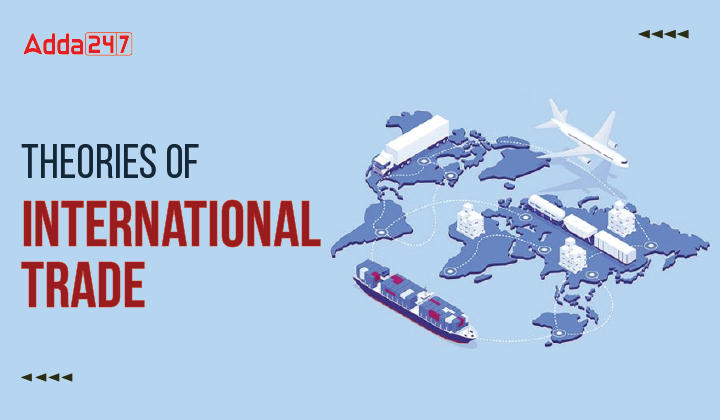Table of Contents
International Trade Theory
International trade is a major contributing factor in global economic activity in developing as well as developed countries. It refers to the exchange of goods and services between two or more two countries. This is a wider phenomenon as compared to domestic trade which is merely concerned with trade within the national boundaries of the country. Thus, international trade implies exchanging goods and services in consideration of money between the residents of one country and the other.
Theories of International Trade
Understanding international trade theories is fundamental for individuals, companies, and nations to comprehend the workings of international trade and business. These theories shed light on the international market, highlight the obstacles that hinder success for businesses, and provide insights into how companies can establish their presence in the global market.
In the domestic business, it is crucial to consider the behaviour and motivation of buyers. However, in international business or trade, it is more important to have a solid grasp of the fundamental causes and nature of business. To achieve this, it is necessary to gain a clear understanding of international trade theories. These are explained below:

I) Classical Theories:
The developers of classical theories follow a country-based approach which is mainly concerned with the fact that preference should be given to raising the wealth of one’s own nation. Major classical theories with regard to international trade are discussed below:
- Mercantilism Theory
- Emerged in – the 16th century
- What this theory states: As per this theory, a country’s wealth was measured by the amount of gold and silver it possessed, which was thought to be the basis of economic power. Mercantilists believed that a country should increase its holdings of gold and silver by promoting exports and discouraging imports.
- To achieve this goal, they advocated for government intervention in trade through protectionist policies, such as tariffs and quotas, and for the development of domestic industries that could produce goods for export. The ultimate objective was to have a trade surplus, where a country exports more than it imports.
2. Absolute Advantage Theory
- Developed by – Adam Smith in the 18th century
- What this theory states: A country should specialize in producing goods and services that it can produce more efficiently than other countries. This specialization will lead to increased efficiency and greater overall output, benefiting both the producing country and the global economy as a whole.
- The theory suggests that free trade should be promoted, as it allows countries to specialize and trade with each other, leading to mutual gains.
- Absolute Advantage theory is based on the idea that nations have different abilities in terms of producing goods and services and that they can benefit from exchanging the goods and services they produce most efficiently.
3. Comparative Advantage
- Developed by – David Ricardo in the early 19th century
- What this theory states: This theory argues that a country should specialize in producing goods in which it has a comparative advantage, meaning it can produce the goods at a lower opportunity cost than other countries. By specializing in this way, countries can increase overall output and trade with each other for mutual benefit.
4. Heckersher Ohline Theory or Factor proportion theory
- Developed by – Eli Heckscher in 1920
- What this theory states: The Heckscher-Ohlin Theory, also known as the Factor Proportion Theory, is an economic theory that suggests that countries will specialize in producing and exporting goods that require abundant factors of production, such as labour or capital, and import goods that require scarce factors of production.
- The theory argues that free trade between countries leads to a more efficient global allocation of resources, as each country specializes in producing goods that it can produce most efficiently. The theory helps to explain why countries specialize in certain industries and how trade can benefit both importing and exporting countries.
II) Modern or firm Based Trade Theories:
These theories emerged during the period of World War II. these are created by professors of business schools and by experts from multinational companies. The following are the modern or firm-based theories:
1.Country Similarity Theory
- Developed by – Steffan Linder in 1961
- What this theory states: Country Similarity Theory is an economic theory that proposes that countries tend to trade more with other countries that are similar to them in terms of culture, language, geography, and economic development.
- The theory suggests that countries with similarities are more likely to have similar demand patterns and preferences for goods and services, and thus are more likely to have a comparative advantage in producing goods that are in demand in their partner country.
- The theory helps to explain why some countries have stronger trade relationships with certain partners, and why trade patterns are often regionally concentrated. However, it has been criticized for oversimplifying the complex factors that influence international trade patterns.
2. Product Life Cycle Theory
- Developed by – Raymond Vernon in the 1960s
- What this theory states: This theory argues that a product goes through three stages: introduction, growth, and maturity. During the introduction stage, the product is produced in the country where it was invented.
- As the product grows, production shifts to countries with lower costs of production. Finally, during the maturity stage, production shifts to countries where the product can be produced most efficiently.
3.Global Strategic Rivalry Theory
- Developed by – Paul Krugman and Kelvin Lancaster in the 1980s
- What this theory states: The Global Strategic Rivalry Theory, also known as the New Trade Theory, suggests that international trade patterns and competitiveness are influenced by factors beyond differences in factor endowments.
- This theory highlights the importance of economies of scale, technological innovation, and government policies in shaping trade patterns. The Global Strategic Rivalry Theory emphasizes the need for countries to invest in developing competitive industries and promoting innovation to gain a strategic advantage in global trade.
4.Porter’s National Competitive Advantage Theory
- Developed by – Michael Porter in the 1985s
- What this theory states: Porter’s National Competitive Advantage Theory, also known as the Diamond Model, proposes that the competitive advantage of an industry in a country depends on four interrelated factors: factor endowments, demand conditions, related and supporting industries, and firm strategy, structure, and rivalry.
- This theory suggests that countries can gain a competitive advantage in specific industries by developing and leveraging these factors. Porter’s theory highlights the importance of factors beyond traditional economic factors, such as industry-specific skills and infrastructure, in shaping the competitiveness of industries.
In a nutshell, Theories of international trade emphasize the importance of competitiveness, innovation, and strategic investments in driving economic growth and shaping international trade patterns. The theories also highlight the complex and multifaceted nature of international trade, and the need for a nuanced understanding of the economic, political, and social factors that shape trade relationships between countries.
Download Theories of international trade PDF
| UGC NET Related Articles | |
| UGC NET Notification 2025 | UGC NET Application Form 2025 |
| UGC NET Previous Year Question Paper | UGC NET Syllabus |




 Odisha LTR Question Paper 2025, Check Su...
Odisha LTR Question Paper 2025, Check Su...
 HPSC Assistant Professor Final Answer Ke...
HPSC Assistant Professor Final Answer Ke...
 HPSC Assistant Professor Question Paper ...
HPSC Assistant Professor Question Paper ...




